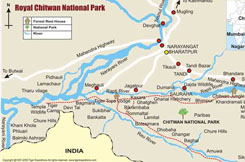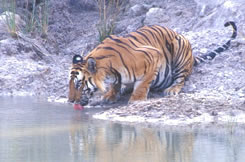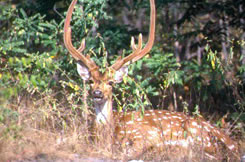The Royal Chitwan National Park is located at subtropical inner Terai lowlands of South-Central Nepal in Chitwan district, 200km away from capital Kathmandu The Park is home to some of the most endangered wildlife species in the world.
Till recent past this park was a playground of Nepal 's elite who has used it for personal hunting today it is the most protected forest zone in the country. Chitwan derives its name from the local word Chituwa Ban or Leopard Forest . But there are many more exceptions to this theory. According to another theory, the park derives its name from Sita Ban ( forest of Sita ), after the heroine of great Hindu epic Ramayana. To substantiate this legend, there is Balmiki Ashram at Triveni where it is said that Sita resided while in exile.
The park was officially established in 1973. In 1984, it became a World Heritage Site as notified by UNESCO. Drained by two major rivers Rapti and Narayani, the park covers subtropical forests housing a variety of wildlife including elephants, royal Bengal tigers, one-horned rhinoceros, leopard, sloth bear, and wild bison. Migration of wildlife across the borders to Valmiki National Park in India is a common thing.
Flora : Park is well protected, one can still experience the feeling of a real-life jungle. Sub-tropical jungles, elephant grasslands, hilly areas, and flood plains are all an integral part of park landscape.
There are two types of forest. The vegetation of Chitwan is tropical moist deciduous and two man types of forest may be recognized i.e. Sal forest and the flood plain forest. On high ground and in the hills where the drainage is good and flooding does not occur is the sal forest so called after the dominat tree sal (shorea robusta). This forest covers roughly three to fourth of the park area and attains a height of 130 ft. Giant vines and creepers, such as debrelahara and bhorla twine upwards using the larger trees for support.
Mammals : In terms of seeing the wildlife, the floodplain belt is the best as it harbors a larger concentration of animals than the sal forest. Chitwan's estimated 450 rhinos are found almost wholly in the grass land and reverine forest. In the Shiwalik hills we find Gaur,of the four species of deer found in Chitwan, the hog deer is restricted in grassland, Chital to the low land part and Sambar and Barking deer are found in the entire the park. Besides ,other wild animals are The tiger, the leopard, and the wild dogs etc.
Mode of Safari : An elephant ride through the park gives you the opportunity to sight the denizens from close quarters, Boat ride on the river through the jungles is also an exciting affair for safari in deep inside.
Excursion Sites : The Gharial Breeding Centre is an important step towards the conservation and research on Gharial, one of the most endangered species.
Lamital and Devital are two lakes flocked by migratory birds during winters.
Bikram Baba is a Hindu religious site while Sauraha is the major commercial hub in the park region.
The Elephant Breeding Centre is a response from the park authorities to increase the number of pachyderms who felicitate visitors transportation inside the park.
Dumaria and Khagendramalli are the particularly good spot for seeing them in February - April.
How to Reach 120 km South West Of Kathmandu on National Highway leading Narayanghtat to Chitwan via Pokhara. It takes anything 5-6 hrs to reach Chitwan.
Where to staty : Adventure Safari Resort & Royal Park Hotel These two facilities situated near Sauraha just outside the National Park provides a more economic way to visit and explore Chitwan. |


